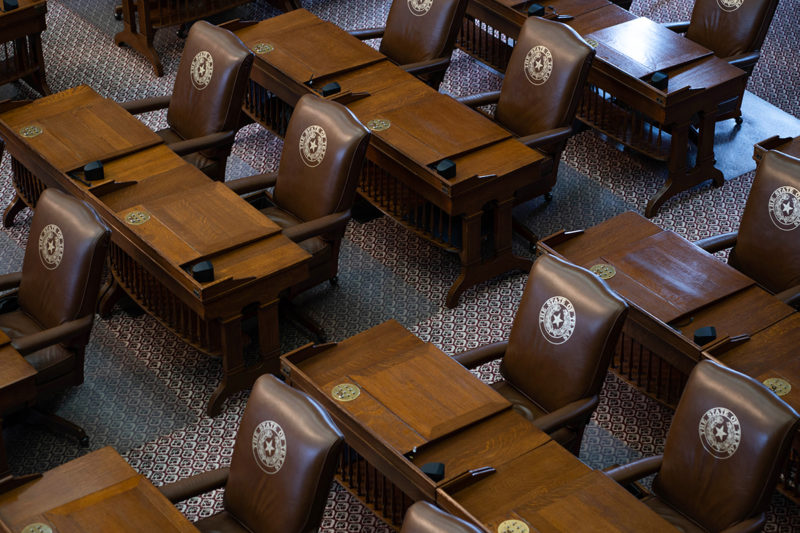For Texas Republicans, a Biennial Legislature Means Less Government
By Claire Allbright
Reporting Texas

Seats in the Texas House of Representatives remain empty most of the year. The legislature meets every other year for 140 days. Nadia Elchmaissani/Reporting Texas
Bulls aren’t the only thing that buck in Texas. Resisting the nationwide trend of state legislatures meeting each year, the Texas House and Senate still meet biennially. In Texas, this means state lawmakers meet every other year for 140 days.
In the early 1960s, 31 state legislatures met every other year, according to the National Conference of State Legislatures. Now, only four states — Montana, Nevada, North Dakota and Texas — meet biennially.
Most states changed to a yearly legislative session for budgeting reasons — because it’s hard to project a state’s assets and expenses, planning a yearly budget is easier than budgeting for two years. But in Texas, where limited government is sacrosanct, efforts to move to an annual legislative schedule have not gained traction.
“To sit there and try to make decisions of what we believe we’re going to get over the next two years in terms of revenue and what we think the needs of the state are going to be over the next two years doesn’t work very well,” said state Rep. Richard Peña Raymond, D-Laredo.
Texas has not been immune from the budgeting challenges that have driven many states to meet annually. If the Legislature had been in session during Hurricane Harvey in August 2017, it could have taken swift action to respond to the storm, Raymond said.
Raymond, who was first elected to the Texas House in 1992, has filed bills during the last several sessions proposing a constitutional amendment to allow the Legislature to meet yearly. Under his measure, the Legislature would meet as it does now, for 140 days every other year, and during off-years would meet for up to 60 days just to write a budget.
This proposal has not garnered much support from Raymond’s colleagues across the aisle, and it would still need to be approved by Texan voters. The last major attempt to reform the state constitution to include an annual session was defeated at a constitutional convention in 1974.

The Capitol rotunda is visited by thousands of tourists every year. Nadia Elchmaissani/Reporting Texas
While state Rep. Gina Hinojosa, D-Austin, said meeting annually would make the Legislature more “nimble” in addressing the state’s needs, meeting biennially has its perks.
“I do also think there are benefits to having some space for thoughtfulness, for vetting ideas in communities and hearings and time when you can’t file bills, because really the hard work of legislation comes in that space,” Hinojosa said.
Talmadge Heflin, a former member of the Texas House of Representatives, said the process of drafting a two-year budget requires better planning on behalf of the Legislature. Heflin, who is director of the conservative Texas Public Policy Foundation’s Center for Fiscal Policy, said this process produces a more thoughtful budget that benefits the state.
“People who think the government is a cure-all think the government should meet every year,” Heflin said. “Thank goodness the people of Texas don’t think that.”
The Texas Legislature did meet annually for seven years during Reconstruction when Republican Gov. Edmund J. Davis implemented the “much-hated” constitution of 1869, said Cal Jillson, a political science professor at Southern Methodist University. That constitution required the state’s legislative branch to meet annually to protect the rights of the newly freed slaves, a role Davis took seriously.
However, Jillson said with the constitution of 1876, which stands today, came the belief that “small government, low taxes and deregulation are better for the Texas economy and society.”
For the time being, Democrats would be “well advised” not to advocate for wanting more government, he added.
“With the changing demographics of Texas and what is expected to be a continued advance … for the Democratic Party, there will be discussions of constitutional reforms of various types, including the possibility of an annual legislative session in the future,” Jillson said.